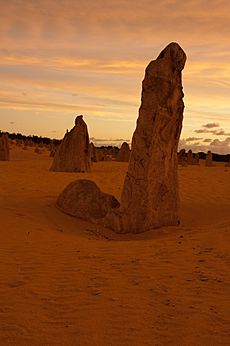The Pinnacles (Western Australia) facts for kids

The Pinnacles are cool limestone rock shapes found inside Nambung National Park. This park is close to the town of Cervantes, Western Australia. These unique rock pillars stand tall in a desert-like area, making it a very special place to visit.
Contents
What Are the Pinnacles Like?
This area has thousands of limestone pillars that have been shaped by nature over a long time. Some of the tallest Pinnacles can reach up to 3.5 meters high, sticking out of the yellow sand.
You'll see different kinds of shapes. Some are tall and thin, looking like columns, which is why they are called "Pinnacles." Others are shorter and wider, like small tombstones.
If you look closely, you might see lines inside some Pinnacles. These lines show how the sand was laid down in different directions long ago. This happened because the wind changed direction while the limestone was forming.
Some Pinnacles have tops that look like mushrooms. This happens when the top layer of rock, called calcrete, is harder than the limestone below it. The softer bottom part wears away faster, leaving the mushroom shape.
How Did the Pinnacles Form?
The material for the Pinnacles came from seashells that lived in the ocean a very long time ago. These shells broke down into sand rich in lime. This sandy material was then blown inland by the wind, forming big sand dunes.
Scientists have different ideas about how these sandy materials turned into the Pinnacles we see today. Here are three main ideas:
- Idea 1: Water Dissolved the Rock
One idea is that the Pinnacles formed when water slowly dissolved the Tamala Limestone. Over time, small holes and channels were made by the water. These holes grew bigger and bigger, creating the tall pillars. Some parts of the Pinnacles might be hardened sand or other materials that filled old spaces, making them stronger against erosion.
- Idea 2: Tree Roots Helped
Another idea suggests that the Pinnacles formed around old tree roots. Imagine trees growing in coastal sand dunes. Their roots would have created paths for groundwater. This water carried minerals, which then hardened around the roots, forming strong calcrete pillars. Later, the wind blew away the softer sand, leaving the hard pillars standing.
- Idea 3: Plants Played a Big Role
A third idea is that plants actively helped create the Pinnacles. As plants pulled water from the soil through their roots, minerals like calcium were also drawn to the roots. In sandy areas with lots of calcium from shells, this calcium built up around the roots and turned into a hard rock called calcrete. When the roots died, the space they left behind also filled with this hard material. While this process has been seen in other parts of the world, scientists are still looking for more proof that it happened here.
Animals and Plants of the Park
You can see many animals and plants living in Nambung National Park.
- Animals:
Western grey kangaroos often eat plants in the park, especially in the morning. They are quite used to people, so you might get to see them up close if you are quiet. You might also spot Baudin's black cockatoos and emus. Other animals include reptiles like bobtails (a type of lizard), sand goannas, and carpet pythons.
- Plants:
The park is home to many interesting plants. Some common ones are panjang (a low-growing wattle), coastal wattle, and banjine. You might also see quandong, yellow tailflower, thick-leaved fanflower, and cockies tongues. Larger plants like parrot bush, candlestick banksia, firewood banksia, and acorn banksia are also common in the park.
Visiting the Pinnacles
Most people didn't know about the Pinnacles until 1967. That's when the area was protected as a reserve. Later, in 1994, it became part of Nambung National Park.
Around 150,000 people visit Nambung National Park each year. In 2008, the Pinnacles Desert Discovery Centre opened. Here, you can learn all about how the Pinnacles formed and the amazing plants and animals that live there.
The best time to visit the Pinnacles is from August to October. The weather is mild, and many wildflowers, including wattle, start to bloom in the spring, making the desert colorful.
There are no places to stay or camp inside Nambung National Park itself. However, you can find places to stay in the nearby town of Cervantes.
Images for kids
See also
 In Spanish: The Pinnacles Desert para niños
In Spanish: The Pinnacles Desert para niños


